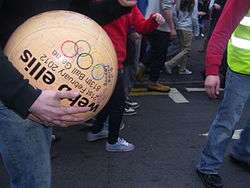Atherstone Ball Game
The Atherstone Ball Game is a "Medieval football" game played annually on Shrove Tuesday in the English town of Atherstone, Warwickshire. The game honours a match played between Leicestershire and Warwickshire in 1199, when teams used a bag of gold as a ball, and which was won by Warwickshire. At one time similar events were held in many towns throughout England, but Atherstone's is now one of only two such games that are played each year at Shrovetide, the other being the Royal Shrovetide Football match held in Ashbourne, Derbyshire.[1]

The two-hour game is played in the town's main street, Long Street, and sees groups of players compete for possession of a giant ball that is specially made for the occasion. The match is usually started at 3.00pm on Shrove Tuesday by a celebrity guest, usually someone associated with the area, who is invited to throw the ball from an upstairs window of the Atherstone branch of Barclays Bank. The game itself has few rules, two being that play is restricted to Long Street and participants are not allowed to kill anyone. The winner is declared at 5.00pm, the title going to the person who has possession of the ball when the whistle sounds.[1][2][3] Ahead of the game itself, sweets and pennies are thrown from Barclays Bank to local children.[4] The ball is decorated with ribbons before the game, and prizes are also awarded to anyone who gets hold of one, as well as to the person who gets the golden penny, thrown into the crowd shortly before the game commences.[5]
Medieval football matches were more common before the 20th century, but their violent nature led the government of the time to pass the Highways Act 1895 to prevent it being played in the streets, although games continued to take place in Atherstone. Before the 1970s the game was played throughout the town, but was restricted to Long Street because the ball frequently ended up in the Coventry Canal. In 1986, a public meeting was held to determine the game's future after that year's event got out of hand. The outcome of this meeting was the formation of a Ball Game committee, which now has responsibility for organising the event.[1]
For several years the ball was made by the sportswear manufacturer Webb Ellis. Following the 2017 game Webb Ellis cancelled their contract to make the ball. As a consequence Atherstone upholsterer Pete Smith was commissioned to produce the ball for the 2018 game. This marked the first occasion the ball had been made in the town since 1982. Smith based his design on an original cardboard template made by local craftsman Brian Brown.[6]
Coverage of the game was first heard on BBC radio in 1934, and footage of it was first shown on television in 1958.[1]
References
- 1 2 3 4 Reid, Nick (26 February 2017). "Atherstone Ball Game: The story behind England's ancient sport". Coventry Telegraph. Trinity Mirror. Archived from the original on 7 May 2017. Retrieved 21 May 2017.
- ↑ Reid, Nick (3 March 2017). "EastEnders star 'honoured' to start 818th Atherstone Ball Game". Tamworth Herald. Local World. Archived from the original on 3 March 2017. Retrieved 21 May 2017.
- ↑ Rodger, James (9 February 2016). "What is the Atherstone Ball Game? Everything you need to know". Coventry Telegraph. Trinity Mirror. Archived from the original on 24 February 2017. Retrieved 21 May 2017.
- ↑ "Coventry and Warwickshire Features – Shrove Tuesday in Atherstone". BBC. 28 October 2014. Archived from the original on 7 November 2015. Retrieved 21 May 2017.
- ↑ Reid, Nick (1 February 2017). "EastEnders star to kick off a 'bigger and better' Atherstone Ball Game". Tamworth Herald. Local World. Retrieved 21 May 2017.
- ↑ Reid, Nick (11 January 2018). "Atherstone Ball Game 2018: Ball made in town for first time in 36 years". Birmingham Mail. Trinity Mirror. Archived from the original on 4 February 2018. Retrieved 4 February 2018.